Canon HFM41, HFM400, HFM40 User Manual
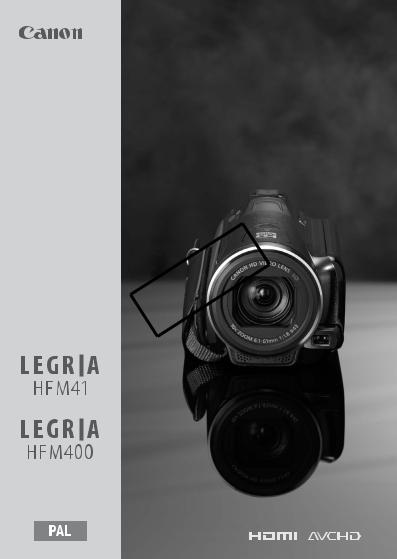
PUB. DIE-0389-000A
HD Camcorder
Instruction Manual




 COPY
COPY
Y
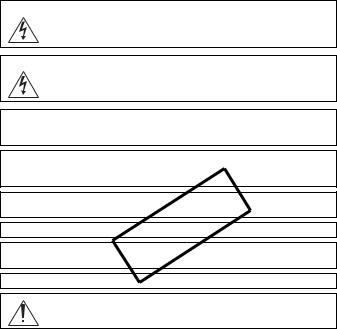
Important Usage Instructions
WARNING!
TO REDUCE THE RISK OF ELECTRIC SHOCK, DO NOT REMOVE COVER (OR BACK). NO USER SERVICEABLE PARTS INSIDE. REFER SERVICING TO QUALIFIED SERVICE PERSONNEL.
WARNING!
TO REDUCE THE RISK OF FIRE OR ELECTRIC SHOCK, DO NOT EXPOSE THIS PRODUCT TO RAIN OR MOISTURE.
COPYRIGHT WARNING:
Unauthorized recording of copyrighted materials may infringe on the rights of copyright owners and be contrary to copyright laws.
CAUTION:
TO REDUCE THE RISK OF ELECTRIC SHOCK AND TO REDUCE ANNOYING INTERFERENCE, USE THE RECOMMENDED ACCESSORIES ONLY.
CAUTION:
DISCONNECT THE MAINS PLUG FROMCOPYTHE SUPPLY SOCKET WHEN NOT IN USE.
To reduce the risk of electric shock, do not expose this product to dripping or splashing.
The Mains plug is used as the disconnect device. The Mains plug shall remain readily operable to disconnect the plug in case of an accident.
CA-570 identification plate is located on the bottom.
Using any device other than the Compact Power Adapter CA-570 may damage the camcorder.
2
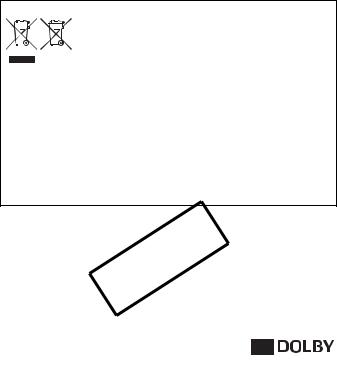
European Union (and EEA) only.
These symbols indicate that this product is not to be disposed of with your household waste, according to the WEEE Directive (2002/96/EC),
the Battery Directive (2006/66/EC) and/or your national laws implementing those Directives.
This product should be handed over to a designated collection point, e.g., on an authorized one-for-one basis when you buy a new similar product or to an authorized collection site for recycling waste electrical and electronic equipment (EEE) and batteries and accumulators. Improper handling of this type of waste could have a possible impact on the environment and human health due to potentially hazardous substances that are generally associated with EEE. Your cooperation in the correct disposal of this product will contribute to the effective usage of natural resources.
For more information about the recycling of this product, please contact your local city office, waste authority, approved scheme or your household waste disposal service or visit www.canon-europe.com/environment.
(EEA: Norway, Iceland and Liechtenstein)
•SD, SDHC and SDXC Logos areCOPYtrademarks of SD-3C, LLC.
•Microsoft and Windows are trademarks or registered trademarks of Microsoft Corporation in the United States and/or other countries.
•Macintosh and Mac OS are trademarks of Apple Inc., registered in the U.S. and other countries.
•“x.v.Color” and the “x.v.Color” logo are trademarks.
•HDMI, the HDMI logo and High-Definition Multimedia Interface are trademarks or registered trademarks of HDMI Licensing LLC in the United States and other countries.
•“AVCHD” and the “AVCHD” logo are trademarks of Panasonic Corporation and Sony Corporation.
•Manufactured under license from Dolby Laboratories. 



 “Dolby” and the double-D symbol are trademarks of Dolby Laboratories.
“Dolby” and the double-D symbol are trademarks of Dolby Laboratories. 






•YouTube is a trademark of Google Inc.
•Other names and products not mentioned above may be trademarks or registered trademarks of their respective companies.
•This device incorporates exFAT technology licensed from Microsoft.
•ANY USE OF THIS PRODUCT OTHER THAN CONSUMER PERSONAL USE IN ANY MANNER THAT COMPLIES WITH THE MPEG-2 STANDARD FOR ENCODING VIDEO INFORMATION FOR PACKAGED MEDIA IS EXPRESSLY PROHIBITED WITHOUT A LICENSE UNDER APPLICABLE PATENTS IN THE MPEG-2 PATENT PORTFOLIO, WHICH LICENSE IS AVAILABLE FROM MPEG LA, L.L.C., 250 STEELE STREET, SUITE 300, DENVER, COLORADO 80206.
•This product is licensed under AT&T patents for the MPEG-4 standard and may be used for encoding MPEG-4 compliant video and/or decoding MPEG-4 compliant video that was encoded only (1) for a personal and noncommercial purpose or (2) by a video provider licensed under the AT&T patents to provide MPEG-4 compliant video. No license is granted or implied for any other use for MPEG-4 standard.
3
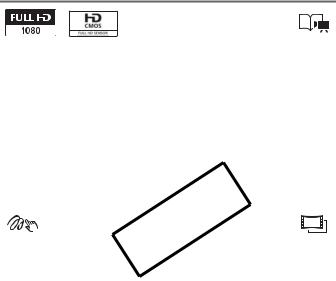
Exciting Features and New Functions
1
Story Creator (061)
Your camcorder’s Full HD CMOS sensor captures video at a resolution of 1,920 x 1,080 pixels2. Videos are then recorded in the memory, using AVCHD specifications3.
With your new HD camcorder, capturing the special moments in your life with amazing image quality and in lifelike vibrant colors is easy and fun!
Transform your movies into compelling video stories just by recording video following simple pre-scripted suggestions, optimized for various scenarios.
|
|
|
|
|
COPY |
||||
Decoration (065) |
|
Cinema-Look Filters |
|
|
|
(063) |
|
|
|
Add flare to your movies by adding |
|
Use professional cinema-look |
||
text, stamps or freehand drawings |
|
filters to create unique movies |
||
directly in the camcorder. |
|
with distinctive looks. |
||
|
|
|
|
|
1“Full HD 1080” refers to Canon camcorders compliant with high-definition video composed of 1,080 vertical pixels (scanning lines).
2Video is recorded at this resolution only when the recording mode is set to MXP or FXP mode. In other recording modes, the picture is recorded at 1,440 x 1,080 pixels.
3AVCHD is a standard for recording high-definition video. With AVCHD specifications, the video signal is recorded using MPEG-4 AVC/H.264 compression and the audio signal is recorded in Dolby Digital.
4
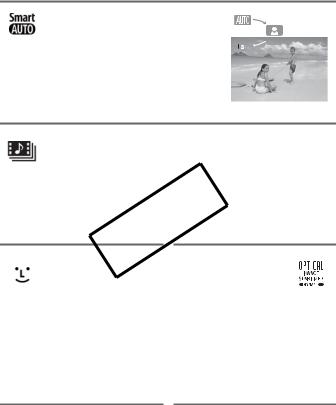
Smart AUTO (044)
Smart AUTO automatically selects the best scene mode for the scene you want to shoot. You get spectacular recordings every time without worrying about settings.
Video Snapshot |
Relay Recording |
f94 |
||||
(064) |
(039) |
497 |
|
|||
|
|
|
|
|
||
Shoot or capture short scenes |
The memory almost full? Use the |
|||||
and arrange them into a video |
double memory card slot to keep |
|||||
clip set to your favorite |
on recording video without |
|||||
background music. |
interruption. |
|
|
|
|
|
Face DetectionCOPYImage Stabilization |
|
|
|
|
|
|
|
|
|
|
|
||
|
|
|
|
|
||
(088) |
|
|
|
|
|
|
|
|
|
|
|
|
|
The camcorder automatically detects people’s faces and adjusts the focus and other settings accordingly for beautiful results.
Dynamic IS (086) compensates for camcorder shake when you shoot video while walking. Powered IS
(087) will produce stable shots when you zoom in on distant subjects (full telephoto).
5
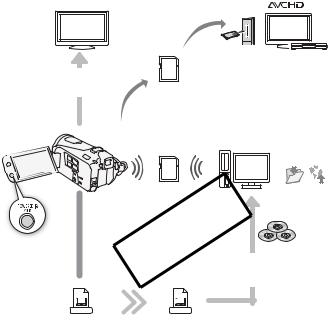
Enjoying your Recordings on Other Devices
|
|
|
|
AVCHD-compatible HDTVs and |
|
Connect the camcorder |
|
|
digital recorders with a card slot |
||
to an HDTV (0126) |
Play video |
|
|
compatible with the type of |
|
|
|
memory card used*. |
|||
|
|
|
|||
|
directly from |
|
|
||
|
|
|
|
|
|
|
your recorded |
|
|
|
|
|
memory card |
|
|
|
|
|
Eye-Fi |
|
|
|
|
Use an Eye-Fi card (0 |
140) |
|
Save or upload to |
||
|
the Web. |
||||
|
to wirelessly upload |
|
|
|
|
|
|
|
|
|
|
recordings to your computer |
|
|
Create |
||
or a video sharing Web site. |
|
|
|||
|
|
discs |
|||
|
|
|
|
|
|
|
|
Use the supplied PIXELA’s |
|||
|
|
software (0130, 135). |
|||
|
COPY |
|
|||
AVCHD |
MPEG-2 |
|
|
|
|
High Definition |
Standard Definition |
|
|
|
|
 Convert your HD movies, in the camcorder itself, to standard definition files (0135).
Convert your HD movies, in the camcorder itself, to standard definition files (0135).
*Refer to the instruction manual of the device. Depending on the device used, correct playback may not be possible even if the device is AVCHD-compatible. In such case, play back the recordings on the memory card using the camcorder.
6
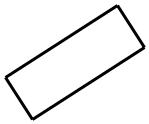
COPY
7
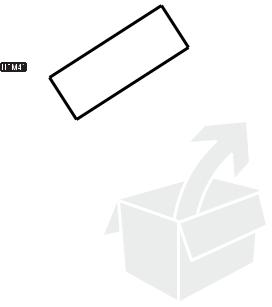
Table of contents
Introduction
4 Exciting Features and New Functions
12 About this Manual
14Getting to Know the Camcorder
14Supplied Accessories and CD-ROMs
16Names of Parts
Preparations
20Getting Started
20 |
Charging the Battery Pack |
22 |
COPY |
Preparing the Accessories |
|
25 |
Adjusting the Position and Brightness of the LCD Screen |
27 |
Using the Viewfinder |
28 Basic Operation of the Camcorder |
|
28 |
Using the Touch Screen |
29 |
Operating Modes |
30 |
Using the Menus |
32 First Time Settings
32Setting the Date and Time
33Changing the Language
33Changing the Time Zone
35 Using a Memory Card
35 Memory Cards Compatible for Use with the Camcorder
37Inserting and Removing a Memory Card
38Selecting the Memory for the Recordings
39Relay Recording
40Initializing the Memory
8 Table of contents
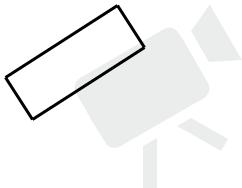
AUTO Mode
42 |
Basic Recording |
42 |
Shooting Video and Taking Photos in AUTO Mode |
44 |
About the Smart AUTO function |
47 |
Zooming |
49Quick Start Function
Video
51Basic Playback
51 |
Playing Back Video |
55 |
3D Flip View |
55The Index Selection Screen: Selecting the Content to Play Back
57 Deleting Scenes and Stories
61 Video Stories and Cinema Style
61 Using Story Creator to Create Compelling Stories
77CopyingCOPYand Moving Scenes Within/Between Stories
78Selecting a Story’s Thumbnail Image
78 Changing a Story’s Title
80 Advanced Functions
80Recording in y(Manual) Mode
81Selecting the Video Quality (Recording Mode)
83Selecting the Frame Rate
83Special Scene Recording Programs
86Advanced Image Stabilization
87Pre-Recording
88Face Detection
90Touch & Track
91Faders
92Manually Setting the Shutter Speed or Aperturse
94Manual Exposure Adjustment
Table of contents 9
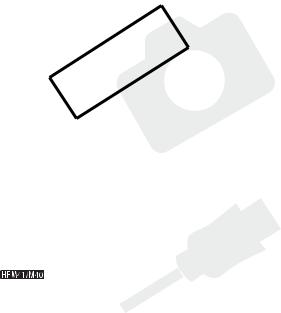
95Automatic Gain Control (AGC) Limit
95Manual Focus Adjustment
97Tele Macro
98White Balance
99Image Effects
100Self Timer
101Audio Recording Level
102Built-In Microphone Directionality
103Audio Equalizer
104Audio Mix
105Using Headphones
106Using the Mini Advanced Shoe
107Using an External Microphone
109Using an External Video Light
110Using a Zoom Remote Controller
111Selecting the Playback Starting Point
112Onscreen Displays and Data Code
113Capturing Photos and Video Snapshot Scenes from a Movie
115Dividing ScenesCOPY
Photos
117Viewing Photos
120Slideshow
External Connections
122Terminals on the Camcorder
123Connection Diagrams
126Playback on a TV Screen
127Saving and Sharing Your Recordings
127Copying Recordings to a Memory Card
130Saving Recordings on a Computer
134Copying Recordings to an External Video Recorder
135 |
Uploading Movies to Video Sharing Web Sites |
10 Table of contents

Additional Information
142 Appendix: Menu Options Lists
142 FUNC. Panel
145 Setup Menus
157 |
Appendix: Onscreen Icons and Displays |
161 |
Trouble? |
161 |
Troubleshooting |
167 |
List of Messages |
175 |
Do’s and Don’ts |
175 |
Handling Precautions |
180Maintenance/Others
181Using the Camcorder Abroad
182General Information
182
183
189
193
Accessories
Optional Accessories
Specifications
Index
COPY
Table of contents 11
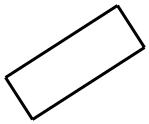
About this Manual
Thank you for purchasing the Canon LEGRIA HF M41 / LEGRIA
HF M40 / LEGRIA HF M400. Please read this manual carefully before you use the camcorder and retain it for future reference. Should your camcorder fail to operate correctly, refer to Troubleshooting (0161).
Conventions Used in this Manual
• IMPORTANT: Precautions related to the camcorder’s operation.
IMPORTANT: Precautions related to the camcorder’s operation.
• NOTES: Additional topics that complement the basic operating procedures.
NOTES: Additional topics that complement the basic operating procedures.
• POINTS TO CHECK: Restrictions or requirements regarding the function described.
POINTS TO CHECK: Restrictions or requirements regarding the function described.
•0: Reference page number within this manual.
•rReferences to sections of the ‘Photo Application’ Instruction Manual, included as a PDF file in the supplied Camcorder Supplemental Disc.
•  : Text that applies only to the models shown in the icon.
: Text that applies only to the models shown in the icon.
• The following terms are used in this manual:
•The photos included in thisCOPYmanual are simulated pictures taken with a still camera. Unless indicated otherwise, illustrations and menu icons refer to the  . term
. term
12 Introduction
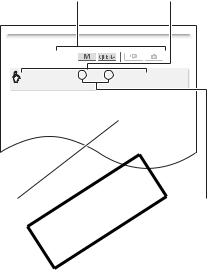
 indicates that a function is available in the operating mode indicated and
indicates that a function is available in the operating mode indicated and  indicates that the function is not available. For a detailed explanation refer to Operating Modes (029).
indicates that the function is not available. For a detailed explanation refer to Operating Modes (029).
Brackets [ ] are used to refer to control buttons and menu options you will touch on the screen and to other onscreen messages and displays.
Self Timer
Operating modes: 
[FUNC.] 8[MENU] 888[Self Timer] 8
[AOn n] 8[a]
•nwill appear on the screen.
•Repeat, selecting [BOff], to turn off the self timer.
Movies: In record pause mode, press g.
The camcorder starts recording after a 10-second countdown*. The countdown appears on the screen.
Photos: In record pause mode, touch [PHOTO].
The camcorder will record the photo after a 10-second countdown*. The countdown appears on the screen.
* 2 seconds when using the wireless controller.
|
COPY |
|
The names of physical buttons |
The 8arrow is used to abbreviate menu selections. |
|
and switches on the |
|
For a detailed explanation on how to use the menus, |
camcorder are indicated within |
refer to Using the Menus (030). For a concise |
|
a “button” frame. |
|
summary of all available menu options and settings, |
For example h. |
|
refer to the appendix Menu Options Lists (0142). |
Introduction 13
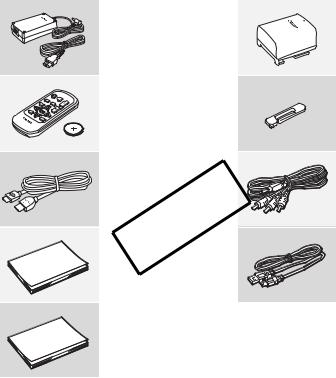
Supplied Accessories and CD-ROMs
The following accessories are supplied with the camcorder:
XCA-570 Compact Power Adapter
(incl. power cord)
BP-808 Battery PackW
XWL-D89 Wireless Controller
(incl. CR2025 lithium button battery)
Stylus PenW
XHTC-100/S HDMI Cable
COPYSTV-250N Stereo Video CableW
XQuick Guide
IFC-300PCU/S USB CableW
XInstallation Guide for PIXELA’s
Software
14 Introduction
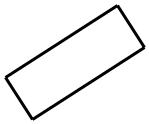
The following CD-ROMs and software are supplied with the camcorder:
•PIXELA’s Transfer Utility CD-ROM*
-Use Transfer Utility for saving and transferring movies and music files you can use as background music.
•PIXELA’s VideoBrowser CD-ROM*
-In addition to all the functionality of Transfer Utility, you can use VideoBrowser for managing, editing, and playing back movies.
•Y Instruction Manual/Photo Applications Ver.35*/Music Data/ Image Mix Data CD-ROM (referred in the manual as “Camcorder Supplemental Disc”). Contains the following components.
-Instruction Manual - The full-version instruction manual of the camcorder (this PDF file).
-Photo Application - Software for saving, managing, and printing photos.
-Music data - Music files that can be used as background music during playback. These music files are for exclusive use with the supplied PIXELA’s software. The disc cannot be played back on CD players.
-Image mix data - Image files that can be used with the image mix function (image mix frames).
* The CD-ROM includesCOPYthe instruction manual of the software (on PDF file).
Introduction 15
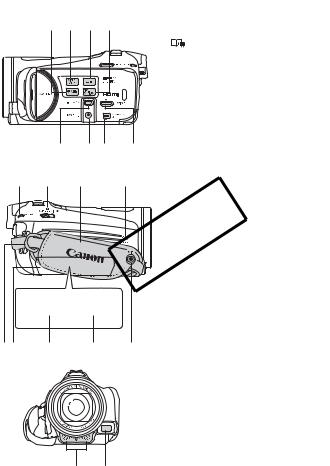
Names of Parts |
|
|
|
|||
Left side view |
|
|
|
|
1 2(camera/play) button (029) |
|
|
|
|
|
2 VIDEO SNAP (video snapshot) button |
||
|
1 |
2 |
3 |
4 |
|
|
|
|
(064) |
||||
|
|
|
|
|
|
|
|
|
|
|
|
|
3 (Story Creator button) (061) |
|
|
|
|
|
|
4 DISP. (onscreen display) button (026, |
|
|
|
|
|
|
112)/ |
|
|
|
|
|
|
BATT. INFO button (0160) |
|
|
|
|
|
|
5 USB terminal (0122, 125, 134) |
|
|
|
|
|
|
6 AV OUT terminal (0122, 124)/ |
|
|
|
|
|
|
X(headphones) terminal (0105) |
|
|
|
|
|
|
7 COMPONENT OUT terminal |
|
5 |
|
6 7 |
8 |
(0122, 124) |
|
|
|
8 HDMI OUT terminal (0122, 123) |
||||
Right side view |
|
|
|
|
||
|
|
|
|
9 ACCESS indicator (042) |
||
9 |
qA |
Aa |
|
|
As |
Aq Mode switch (029) |
|
|
|
|
|
|
Aa Grip belt (023) |
|
|
|
|
|
|
As Speaker (053) |
|
|
|
|
|
|
Ad Strap mount (023) |
|
|
|
|
|
|
Af Double memory card slot cover |
|
|
|
|
|
|
Ag Memory card slot X(037) |
|
|
|
|
|
|
Ah Memory card slot Y(037) |
|
|
|
|
|
|
Aj MIC terminal (0108, 108) |
|
|
|
|
|
COPYAk Stereo microphone (0101, 102) |
|
|
|
|
|
|
|
Al Instant AF sensor (0147) |
dAf |
Ag |
|
Ah |
|
Aj |
|
Front view
Ak Al
16 Introduction
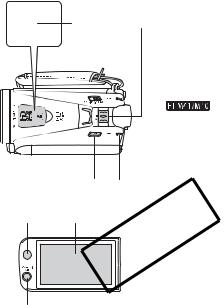
Top view
LCD panel
Sf
Sh
|
Sq Mini advanced shoe (0106) |
|
Sa Zoom lever (047) |
|
Ss POWER button |
Sq |
Sa Sd ON/OFF (CHG) (charge) indicator: |
|
Green – ON |
|
Orange – Standby (049) |
|
Red – Charging (020) |
|
Sf Remote sensor (022) |
|
Sg LCD touch screen (025, 28) |
|
Sh POWERED IS button (087)/ |
|
WEB button (0135) |
Ss Sd
Sg |
COPY |
Introduction 17
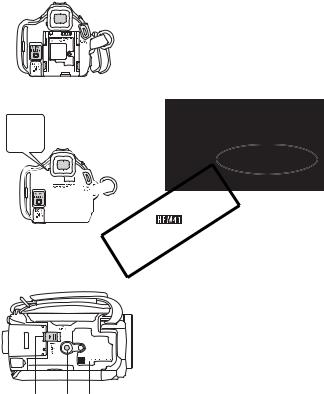
Back view |
jS Battery attachment unit (020) |
Sj |
kS START/STOP button (042) |
Sk |
|
|
lS DC IN terminal (020) |
|
qD RESET button (0165) |
|
aD Dioptric adjustment lever* (027) |
|
sD Viewfinder* (027) |
|
dD VIEWFINDER button* (027) |
|
fD BATTERY RELEASE switch (021) |
|
gD Tripod socket (0176) |
|
hD Serial number |
Sl |
Dq |
Ds
aD
Dd
Bottom view
 COPY* only.
COPY* only.
Df Dg Dh
18 Introduction
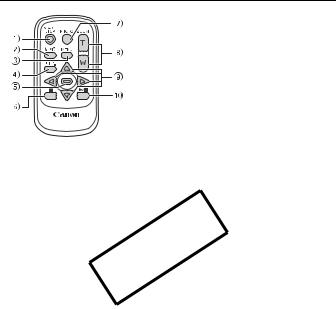
Wireless Controller WL-D89
1 START/STOP button (042)
2 b(index selection) button (055) Press and hold for more than 2 seconds to switch between shooting and playback mode.
3 MENU button (031, 145)
4 DISP. (onscreen display) button (0112)
5 SET button
6 B(stop) button (051)
7 PHOTO button (042)
8 Zoom buttons (047)
9 Navigation buttons ( Z/O/y/A) Aq A/C(play/pause) button (051)
COPY
Introduction 19
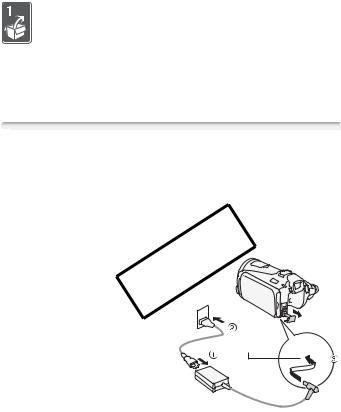
Preparations
This chapter describes basic operations, such as using the touch panel, navigating the menus, and first time settings to help you learn more about your camcorder.
Getting Started
Charging the Battery Pack
The camcorder can be powered with a battery pack or directly using the compact power adapter. The first time you use a battery pack, fully charge it and then use the camcorder until the battery pack is completely exhausted. Doing so will ensure that the remaining recording time will be displayed accurately.
For approximate charging times and recording/playback times with a fully charged battery pack, refer to Charging, Recording and Playback Times (0184).
1 |
Connect the power cord to the |
|
|
compact power adapter. |
|
2 |
Plug the power cord into a |
|
|
power outlet. |
COPY |
3 |
|
|
Connect the compact power |
||
adapter to the camcorder’s DC
DC IN terminal
IN terminal.
4Attach the battery pack to the camcorder.
Press the battery pack softly into the battery attachment unit and slide it up until it clicks in place.
20 Preparations
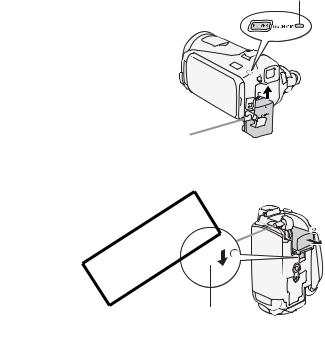
5Charging will start when the camcorder is turned off.
•If the camcorder was on, the green ON/OFF (CHG) indicator will go out when you turn off the camcorder. After a moment, the ON/OFF (CHG) indicator will start flashing in red (battery pack charging). The red ON/ OFF (CHG) indicator will go out when the battery pack is fully charged.
•If the indicator flashes quickly, refer to Troubleshooting (0164).
To remove the battery pack
ON/OFF (CHG) (charge) indicator
 4
4
1 |
Slide Uin the |
|
|
direction of the arrow and hold it |
|
|
pressed down. |
COPY |
|
|
|
2 |
Slide the battery pack and |
|
|
then pull it out. |
|
BATTERY RELEASE switch
 IMPORTANT
IMPORTANT
•Turn off the camcorder before connecting or disconnecting the compact power adapter. After pressing xto turn off the camcorder, important data is updated in the memory. Be sure to wait until the green ON/OFF (CHG) indicator goes out.
•Do not connect to the camcorder’s DC IN terminal or to the compact power adapter any electrical equipment that is not expressly recommended for use with this camcorder.
•To prevent equipment breakdowns and excessive heating, do not connect the supplied compact power adapter to voltage converters for overseas travels or special power sources such as those on aircraft and ships, DC-AC inverters, etc.
Preparations 21
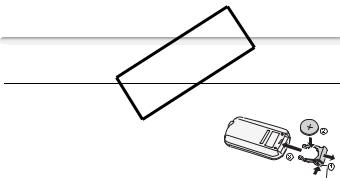
 NOTES
NOTES
•We recommend charging the battery pack in temperatures between 10 °C and 30 °C. If either the ambient temperature or the battery pack’s temperature is outside the range of approx. 0 °C to 40 °C, charging will not start.
•The battery pack will be charged only when the camcorder is off.
•If the power supply was disconnected while charging a battery pack, make sure the ON/OFF (CHG) indicator has gone out before restoring the power supply.
•If remaining battery time is an issue, you can power the camcorder using the compact power adapter so the battery pack will not be consumed.
•Charged battery packs continue to discharge naturally. Therefore, charge them on the day of use, or the day before, to ensure a full charge.
•We recommend that you prepare battery packs to last 2 to 3 times longer than you think you might need.
Preparing the AccessoriesCOPY
Wireless Controller
First, insert the supplied R2025 lithium button battery into the wireless controller.
1 Press the tab in the direction of the
arrow and pull out the battery holder.
2Place the lithium button battery with the + side facing up.
3 Insert the battery holder. |
Tab |
To use the wireless controller
Point the wireless controller at the camcorder’s remote sensor when you press the buttons.
You can rotate the LCD panel 180 degrees to use the wireless controller from the front of the camcorder.
22 Preparations
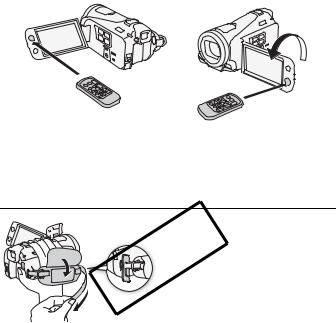
 NOTES
NOTES
•The wireless controller may not work properly when the remote sensor is situated under strong light sources or direct sunlight.
Grip Belt and Straps
Fasten the grip belt.
COPYAdjust the grip belt so that you can reach the zoom lever with your index
finger, and the gbutton with your thumb.
You can attach the supplied stylus pen to the grip belt.
To remove the grip belt
1Lift the padded handgrip’s flap and detach the strap from the Velcro pad.
2Pull the strap to remove it first from the front bracket on the camcorder, then to unthread it from the handgrip and finally to remove it from the rear bracket on the camcorder.
Preparations 23
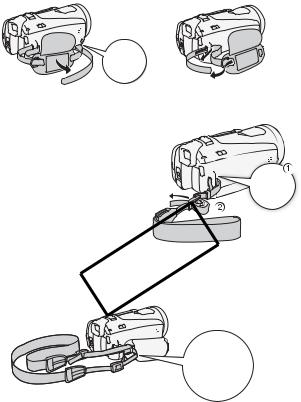
To attach an optional wrist strap
Attach the wrist strap to the rear bracket on the camcorder, adjust the length and fasten.
You can also attach the wrist strap to the strap mount on the grip belt to use both for extra convenience and protection.
To attach an optional shoulderCOPYstrap
Pass the ends of the shoulder strap through the strap mount on the grip belt and adjust the length of the strap.
24 Preparations
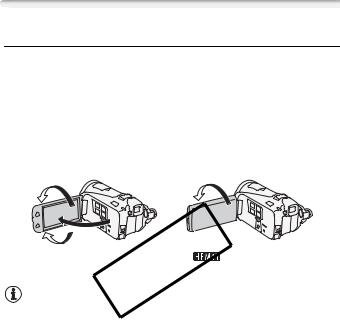
Adjusting the Position and Brightness of the LCD Screen
Rotating the LCD Panel
Open the LCD panel 90 degrees.
•You can rotate the panel 90 degrees downward.
•You can rotate the panel 180 degrees toward the lens. Rotating the LCD panel 180 degrees can be useful in the following cases:
- To allow the subject to monitor the LCD screen while you use the viewfinder.
To allow the subject to monitor the LCD screen while you use the viewfinder.
-To include yourself in the picture when recording with the self timer.
-To allow the camcorder to be operated with the wireless controller from the front.
180° |
180° |
•About the LCD and viewfinder*COPYscreens: The screens are produced using extremely high-precision manufacturing techniques, with more than 99.99% of the pixels operating to specification. Less than 0.01% of the pixels may occasionally misfire or appear as black, red, blue or green dots. This has no effect on the recorded image and does not constitute
a malfunction.
*  only.
only.
Preparations 25
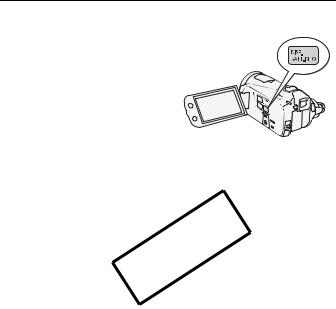
LCD Backlight
When recording in bright places it may be difficult to use the LCD screen. Turn on the LCD backlight to make it brighter.
With the camcorder on, hold hpressed down for more than 2 seconds.
Repeat this action to switch the LCD backlight between off (normal) and on (bright).
 NOTES
NOTES
•The LCD backlight does not affect the brightness of the recordings.
•Using the bright setting will shorten the effective usage time of the battery pack.
•You can further adjust the brightness of the LCD screen with the 68[LCD Brightness]COPYsetting, or dim it with the 68[LCD Screen Dimmer] setting to use in places where the light from the LCD screen can be a nuisance.
•For details about how to take care of the touch screen, refer to Handling
26 Preparations
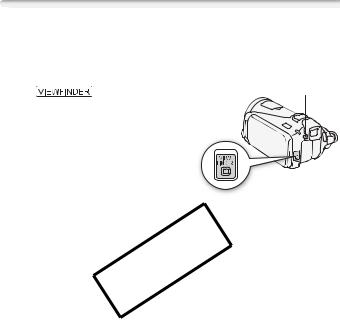
 Using the Viewfinder
Using the Viewfinder
If it is difficult to use the LCD screen even after turning on the LCD backlight, you can use the viewfinder. You can also use the viewfinder when you rotate the LCD panel 180 degrees to let the subject watch the recording.
Press |
to activate the |
Dioptric adjustment lever |
|
||
viewfinder. |
|
|
• You can close the LCD panel or rotate it toward the subject as you prefer.
• Adjust the viewfinder as necessary with the dioptric adjustment lever.
• The LCD backlight setting is common to the LCD screen and the viewfinder.
 NOTES
NOTES
•For details about how to take care of the viewfinder, refer to Handling Precautions (0175),COPYCleaning (0 180).
Preparations 27
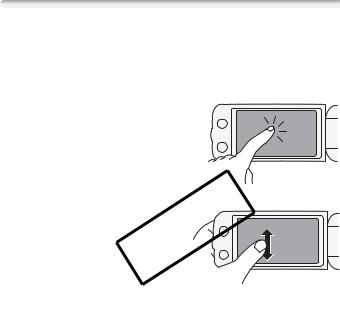
Basic Operation of the Camcorder
Using the Touch Screen
The control buttons and menu items that appear on the touch screen change dynamically depending on the operating mode and the task you are performing. With the intuitive touch screen interface you have all the controls at your fingertips. You can also use the supplied stylus pen for a more precise operation.
Touch
Press firmly on an element displayed on the touch screen.
Used to start playing back a scene in an index screen, to select a setting from the menus, to select the subject whom the camcorder will recognize as the main subject of the scene, etc.
Drag
While applying pressure, swipe your finger up and down or left and right
across the screen.
COPY
Used to scroll menus, to browse through index screen pages or to adjust slider controls like the volume.
 IMPORTANT
IMPORTANT
•The camcorder uses a pressure-sensitive touch screen. Press firmly when using touch operations.
•In the following cases, you may not be able to perform touch operations correctly.
-Using your fingernails or hard-tipped objects other than the supplied stylus pen, such as ballpoint pens.
-Operating the touch screen with wet or gloved hands.
-Applying excessive force or forcefully scratching the touch screen.
-Attaching commercially available screen protectors or adhesive film onto the touch screen’s surface.
28 Preparations

Operating Modes
Recording
In recording mode, the camcorder’s operating mode is determined by the position of the mode switch.
Operating mode Mode switch |
Operation |
|
Let the camcorder take care of all the settings while |
|
you concentrate on recording (042). Great for |
|
beginners or if you just prefer not to bother with |
|
detailed camcorder settings. |
|
Enjoy full access to menus, settings and advanced |
|
functions (080). |
|
Give your recordings a cinematic look and use cinema- |
|
look filters to create unique movies (063). |
Playback |
COPY |
|
Press the camera/play button Sto switch the camcorder between camera (recording) mode and playback mode. You can press Swhen the camcorder is off to turn it on directly in playback mode.
Operating mode |
Operation |
|
|
Playing back movies (051).
Viewing photos (0117).
NOTES
•When switching to a playback mode, the memory selected for playback will be the same currently used for recording.
•You can also press and hold Bon the wireless controller for more than 2 seconds to switch between recording and playback mode.
Preparations 29
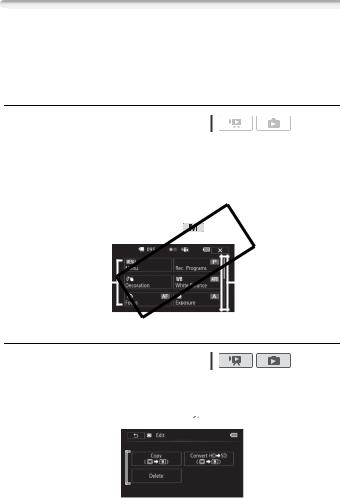
Using the Menus
Many of the camcorder’s functions can be adjusted from the FUNC. panel and the setup menus. For details about the available menu options and settings, refer to the appendix Menu Options Lists
(0142).
FUNC. Panel
Operating modes: 


The FUNC. panel shows a convenient overview of frequently used shooting functions. Touch [FUNC.] to access the FUNC. panel and then touch the function you want to set or adjust.
You may need to drag your finger up and down along the scroll bar to find the control button of the desired function. In  mode, access to functions is limited.
mode, access to functions is limited.
|
FUNC. panel in |
mode |
|||||
Touch the control |
|
|
COPY |
|
|
|
|
|
|
|
|
|
|||
|
|
||||||
|
|
|
|
|
|
|
|
button of the |
|
|
|
|
|
|
|
desired function |
|
|
|
|
|
|
|
|
|
|
|
|
|
|
|
Drag your finger up and down along the scroll bar to display the rest of the panel
Edit Panel
Operating modes: 


Touch [Edit] to display a panel showing available operations (copying, deleting, etc.), and then touch the operation you want to perform.
Edit panel in  mode
mode
Touch the control button of the desired operation
button of the desired operation
30 Preparations
